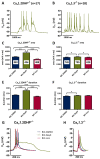Cav 1.3 channels play a crucial role in the formation of paroxysmal depolarization shifts in cultured hippocampal neurons
- PMID: 28295232
- PMCID: PMC7116787
- DOI: 10.1111/epi.13719
Cav 1.3 channels play a crucial role in the formation of paroxysmal depolarization shifts in cultured hippocampal neurons
Abstract
Objective: An increase of neuronal Cav 1.3 L-type calcium channels (LTCCs) has been observed in various animal models of epilepsy. However, LTCC inhibitors failed in clinical trials of epileptic treatment. There is compelling evidence that paroxysmal depolarization shifts (PDSs) involve Ca2+ influx through LTCCs. PDSs represent a hallmark of epileptiform activity. In recent years, a probable epileptogenic role for PDSs has been proposed. However, the implication of the two neuronal LTCC isoforms, Cav 1.2 and Cav 1.3, in PDSs remained unknown. Moreover, Ca2+ -dependent nonspecific cation (CAN) channels have also been suspected to contribute to PDSs. Nevertheless, direct experimental support of an important role of CAN channel activation in PDS formation is still lacking.
Methods: Primary neuronal networks derived from dissociated hippocampal neurons were generated from mice expressing a dihydropyridine-insensitive Cav 1.2 mutant (Cav 1.2DHP-/- mice) or from Cav 1.3-/- knockout mice. To investigate the role of Cav 1.2 and Cav 1.3, perforated patch-clamp recordings were made of epileptiform activity, which was elicited using either bicuculline or caffeine. LTCC activity was modulated using the dihydropyridines Bay K 8644 (agonist) and isradipine (antagonist).
Results: Distinct PDS could be elicited upon LTCC potentiation in Cav 1.2DHP-/- neurons but not in Cav 1.3-/- neurons. In contrast, when bicuculline led to long-lasting, seizure-like discharge events rather than PDS, these were prolonged in Cav 1.3-/- neurons but not in Cav 1.2DHP-/- neurons. Because only the Cav 1.2 isoform is functionally coupled to CAN channels in primary hippocampal networks, PDS formation does not require CAN channel activity.
Significance: Our data suggest that the LTCC requirement of PDS relates primarily to Cav 1.3 channels rather than to Cav 1.2 channels and CAN channels in hippocampal neurons. Hence, Cav 1.3 may represent a new therapeutic target for suppression of PDS development. The proposed epileptogenic role of PDSs may allow for a prophylactic rather than the unsuccessful seizure suppressing application of LTCC inhibitors.
Keywords: CAN channels; Epileptogenesis; L-type voltage-gated calcium channels; Primary cultured hippocampal neurons.
Wiley Periodicals, Inc. © 2017 International League Against Epilepsy.
Conflict of interest statement
None of the authors has any conflict of interest to disclose. We confirm that we have read the Journal’s position on issues involved in ethical publication and affirm that this report is consistent with those guidelines.
Figures





Similar articles
-
The Paroxysmal Depolarization Shift: Reconsidering Its Role in Epilepsy, Epileptogenesis and Beyond.Int J Mol Sci. 2019 Jan 29;20(3):577. doi: 10.3390/ijms20030577. Int J Mol Sci. 2019. PMID: 30699993 Free PMC article. Review.
-
Raised activity of L-type calcium channels renders neurons prone to form paroxysmal depolarization shifts.Neuromolecular Med. 2013 Sep;15(3):476-92. doi: 10.1007/s12017-013-8234-1. Epub 2013 May 22. Neuromolecular Med. 2013. PMID: 23695859 Free PMC article.
-
Cav1.2 and Cav1.3 L-type calcium channels operate in a similar voltage range but show different coupling to Ca(2+)-dependent conductances in hippocampal neurons.Am J Physiol Cell Physiol. 2014 Jun 15;306(12):C1200-13. doi: 10.1152/ajpcell.00329.2013. Epub 2014 Apr 23. Am J Physiol Cell Physiol. 2014. PMID: 24760982 Free PMC article.
-
Dynamic interplay of excitatory and inhibitory coupling modes of neuronal L-type calcium channels.Am J Physiol Cell Physiol. 2011 Apr;300(4):C937-49. doi: 10.1152/ajpcell.00219.2010. Epub 2011 Jan 12. Am J Physiol Cell Physiol. 2011. PMID: 21228322 Free PMC article.
-
Cav 1.3-selective inhibitors of voltage-gated L-type Ca2+ channels: Fact or (still) fiction?Br J Pharmacol. 2023 May;180(10):1289-1303. doi: 10.1111/bph.16060. Epub 2023 Mar 14. Br J Pharmacol. 2023. PMID: 36788128 Free PMC article. Review.
Cited by
-
Overexpression of BDNF Suppresses the Epileptiform Activity in Cortical Neurons of Heterozygous Mice with a Transcription Factor Sip1 Deletion.Int J Mol Sci. 2024 Sep 30;25(19):10537. doi: 10.3390/ijms251910537. Int J Mol Sci. 2024. PMID: 39408863 Free PMC article.
-
Acute Focal Seizures Start As Local Synchronizations of Neuronal Ensembles.J Neurosci. 2019 Oct 23;39(43):8562-8575. doi: 10.1523/JNEUROSCI.3176-18.2019. Epub 2019 Aug 19. J Neurosci. 2019. PMID: 31427393 Free PMC article.
-
Role of paroxysmal depolarization in focal seizure activity.J Neurophysiol. 2019 Nov 1;122(5):1861-1873. doi: 10.1152/jn.00392.2019. Epub 2019 Aug 28. J Neurophysiol. 2019. PMID: 31461373 Free PMC article. Review.
-
The Paroxysmal Depolarization Shift: Reconsidering Its Role in Epilepsy, Epileptogenesis and Beyond.Int J Mol Sci. 2019 Jan 29;20(3):577. doi: 10.3390/ijms20030577. Int J Mol Sci. 2019. PMID: 30699993 Free PMC article. Review.
-
Of the Mechanisms of Paroxysmal Depolarization Shifts: Generation and Maintenance of Bicuculline-Induced Paroxysmal Activity in Rat Hippocampal Cell Cultures.Int J Mol Sci. 2023 Jul 1;24(13):10991. doi: 10.3390/ijms241310991. Int J Mol Sci. 2023. PMID: 37446169 Free PMC article.
References
-
- Calin-Jageman I, Lee A. Cav1 L-type Ca2+ channel signaling complexes in neurons. J Neurochem. 2008;105:573–583. - PubMed
-
- Zhang Z, Séguéla P. Metabotropic induction of persistent activity in layers II/III of anterior cingulate cortex. Cereb Cortex. 2010;20:2948–2957. - PubMed
-
- Kulak W, Sobaniec W, Wojtal K, et al. Calcium modulation in epilepsy. Pol J Pharmacol. 2004;56:29–41. - PubMed
-
- Amano H, Amano T, Matsubayashi H, et al. Enhanced calcium influx in hippocampal CA3 neurons of spontaneously epileptic rats. Epilepsia. 2001;42:345–350. - PubMed
Publication types
MeSH terms
Substances
Grants and funding
LinkOut - more resources
Full Text Sources
Other Literature Sources
Miscellaneous

